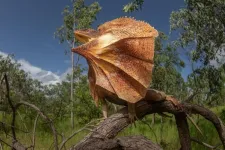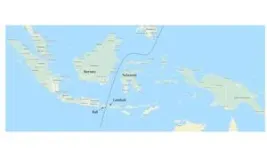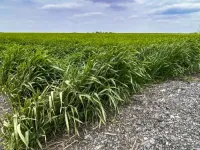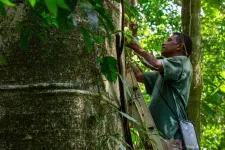(Press-News.org) If you travel to Bali, you won’t see a cockatoo, but if you go to the neighbouring island of Lombok, you will. The situation is similar with marsupials: Australia is home to numerous marsupial species, such as the kangaroo and the koala. The further west you go, the sparser they become. While you will find just two representatives of these typically Australian mammals on the Indonesian island of Sulawesi, you will search in vain for them on neighbouring Borneo. Australia, on the other hand, is not home to mammals that you will typically find in Asia, such as bears, tigers or rhinos.
This abrupt change in the composition of the animal world already caught the eye of the British naturalist and co-discoverer of evolutionary theory Alfred Russell Wallace, who travelled through the Indo-Australian Archipelago from 1854 to 1862 to collect animals and plants. He described an (invisible) biogeographical line running between Bali and Lombok and Borneo and Sulawesi that marked the westernmost distribution of Australian fauna.
Fascinating change of wildlife
Biodiversity researchers have long been fascinated by this abrupt change of creatures along the Wallace Line. How these distribution patterns came about, however, has not yet been clarified in detail.
One explanation is plate tectonics. Forty-five million years ago, the Australian Plate began to drift northwards and slid under the mighty Eurasian Plate. This brought two land masses closer together that had previously been far apart. It became easier for land creatures to colonise one continent from the other. Tectonic movements also gave rise to the creation of countless (volcanic) islands between the two continents, which animals and plants used as stepping stones to migrate westwards or eastwards.
More Asian animals in Australia than vice versa
But why more species found their way from Asia to Australia – countless poisonous snakes, thorny lizards (Moloch horridus), hopping mice (Notomys sp.) or flying foxes bear witness to this – than the other way round has been a mystery until now.
In order to better understand this asymmetrical vertebrate distribution along the Wallace Line, researchers led by Loïc Pellissier, Professor of Ecosystems and Landscape Evolution at ETH Zurich, have created a new model. It combines reconstructions of the climate, plate displacements between 30 million years ago and the present day and a comprehensive data set for around 20,000 birds, mammals, reptiles and amphibians that are recorded in the region today.
Climates in areas of origin decisive
In the latest issue of Science, the researchers now show that adaptations to the climates in the areas of origin are partly responsible for the uneven distribution of Asian and Australian faunal representatives on both sides of the Wallace Line.
In addition to plate tectonics, the environmental conditions that prevailed millions of years ago were decisive for the exchange between the two continents. Based on simulations, the researchers found that animals originating from Asia were more likely to “hop” across the Indonesian islands to reach New Guinea and northern Australia.
These islands featured a tropically humid climate, which they were comfortable with and had already adapted to. The Australian wildlife was different, having evolved in a cooler climate that had become increasingly drier over time, and was therefore less successful in gaining a foothold on the tropical islands than the fauna migrating from Asia.
The Asian climate thus favoured creatures that reached Australia via the tropical islands of the faunal region known as Wallacea, especially those that could tolerate a wide range of climates. This made it easier for them to settle on the new continent. “The historical context is crucial for understanding the biodiversity distribution patterns observed today and was the missing piece of the puzzle explaining the enigma of Wallace’s line," says first author Alexander Skeels, a postdoctoral researcher in Pellissier’s group.
Competitive advantages for tropical species
Traits of species that evolved in tropical habitats include faster growth and higher competitiveness to enable them to withstand the pressure of coexistence with many other species. In harsher climates, such as the colder and drier regions of Australia, organisms usually have to evolve special adaptations to cope with drought and heat stress. These include behavioural adaptations such as nocturnal activity and physiological adaptations to minimise water loss. “Many Australian frogs bury themselves in the ground and remain dormant for long periods for this reason,” Skeels points out. “Something that is rare in tropical frogs.”
The findings are important for the researchers: “They make it clear that we can only understand today’s distribution patterns of biodiversity if we include the geological development and climatic conditions of prehistoric times in our considerations,” says Pellissier.
The heritage of long past epochs has shaped the patterns of biodiversity right up to the present. It also helps us to understand why more species are found in the tropics today than in temperate latitudes. “To fully understand the distribution of biodiversity and the processes that maintain it in the present, we need to find out how it came about,” says the researcher.
Learning to understand invasive species
This is especially true in biogeography because the exchange of species between continents continues to take place regularly and at an alarming rate today as humans move animals and plants around the planet. These species can become invasive on other continents and harm the ancestral fauna and flora. “Knowing the factors that influence exchange on long time scales is important to understanding why species can become invasive on more recent time scales. In the current biodiversity crisis, this can help us to better assess the consequences of human-induced invasions,” Skeels emphasises.
END
Why there are no kangaroos in Bali (and no tigers in Australia)
2023-07-06
ELSE PRESS RELEASES FROM THIS DATE:
MIT physicists generate the first snapshots of fermion pairs
2023-07-06
CAMBRIDGE, Mass. -- When your laptop or smartphone heats up, it’s due to energy that’s lost in translation. The same goes for power lines that transmit electricity between cities. In fact, around 10 percent of the generated energy is lost in the transmission of electricity. That’s because the electrons that carry electric charge do so as free agents, bumping and grazing against other electrons as they move collectively through power cords and transmission lines. All this jostling generates friction, and, ultimately, heat.
But when electrons pair up, they can rise above the fray and glide through a material without ...
Prize winner reveals how commensal-derived “silent” flagellins evade innate immunity
2023-07-06
Sara Clasen is the 2023 winner of the NOSTER & Science Microbiome Prize for her work in illuminating how “silent flagellins” from commensal microbiota evade a host’s innate immunity.
The NOSTER & Science Microbiome Prize aims to reward innovative research from young investigators working on the functional attributes of the microbiota of any organism that has potential to contribute to our understanding of health and disease, or to guide novel therapeutic interventions.
Strong adaptive immune responses require activation of innate immunity. To do this, innate ...
Researchers demonstrate first visible wavelength femtosecond fiber laser
2023-07-06
WASHINGTON — Researchers have developed the first fiber laser that can produce femtosecond pulses in the visible range of the electromagnetic spectrum. Fiber lasers producing ultrashort, bright visible-wavelength pulses could be useful for a variety of biomedical applications as well as other areas such as material processing.
Visible femtosecond pulses are usually obtained using complex and inherently inefficient setups. Although fiber lasers represent a very promising alternative due to their ruggedness/reliability, small footprint, efficiency, lower cost and high brightness, it hasn’t been possible, until now, to produce visible pulses with durations in the femtosecond ...
Top corn producing state to see future drop in yield, cover crop efficiency
2023-07-06
URBANA, Ill. — Winter cover crops could cut nitrogen pollution in Illinois’ agricultural drainage water up to 30%, according to recent research from the University of Illinois Urbana-Champaign. But how will future climate change affect nitrogen loss, and will cover crops still be up to the job? A new study investigating near- and far-term climate change in Illinois suggests cover crops will still be beneficial, but not to the same degree. The report also forecasts corn ...
New study: Black women with hypertensive disorders of pregnancy have increased stroke risk
2023-07-06
(Boston) – U.S. Black women have a disproportionately higher burden of both preeclamptic pregnancy and stroke compared with white women, but virtually all existing evidence on the association between the two medical conditions has come from studies of white women.
A newly published study focuses on data gathered over 25 years from 59,000 Black women in the Black Women’s Health Study (BWHS) and is led by researchers from Boston University Chobanian & Avedisian School of Medicine and Slone Epidemiology Center. The study, published in the New England Journal of Medicine Evidence, ...
Bezos Earth Fund grants $12 million to Smithsonian to support major forest carbon project
2023-07-06
By conserving and replanting forests, the world buys time until it brings other climate and sustainability solutions online. As a critical step toward this goal, the Smithsonian Tropical Research Institute (STRI) received a $12 million grant from the Bezos Earth Fund to support GEO-TREES. This international consortium is the first worldwide system to independently ensure the accuracy of satellite monitoring of forest biomass—a way to measure carbon stored in trees—in all forest types and conditions. The GEO-TREES alliance offers a freely accessible database that integrates ...
Legends of Norse Settlers drove Denmark towards Greenland
2023-07-06
In 985, Viking explorer Erik the Red led a group of Icelandic farmers to Greenland, where they established a settlement on the west coast. Archaeological evidence suggests that the settlement existed for over 400 years, but the impact of the settlement lasted much longer. It is little recognised today that the hope of finding the descendants of the settlers dominated European and American perspectives on Greenland for centuries
In his new book The Vanished Settlers of Greenland: In Search of a Legend and Its Legacy, Associate Professor Robert Rix argues that the lost Norse settlement played a decisive ...
Archaeology: The power of the Copper Age 'Ivory Lady' revealed
2023-07-06
The highest status individual in ancient Copper Age society in Iberia, was a woman and not a man as previously thought, according to peptide analysis reported in Scientific Reports. The individual, now re-dubbed the 'Ivory Lady', was buried in a tomb filled with the largest collection of rare and valuable items in the region, including ivory tusks, high-quality flint, ostrich eggshell, amber, and a rock crystal dagger. These findings reveal the high status women could hold in this ancient society.
In 2008, an individual was discovered in a tomb in Valencia, Spain dating to the Copper Age between 3,200 and 2,200 years ago. As well as being a rare example of a single occupancy ...
Schizophrenia is associated with somatic mutations occurring in utero
2023-07-06
As a psychiatric disorder with onset in adulthood, schizophrenia is thought to be triggered by some combination of environmental factors and genetics, although the exact cause is still not fully understood. In a study published in the journal Cell Genomics on July 6, researchers find a correlation between schizophrenia and somatic copy-number variants, a type of mutation that occurs early in development but after genetic material is inherited. This study is one of the first to rigorously describe the relationship between somatic—not inherited—genetic mutations and schizophrenia risk.
“We originally thought of genetics as the study of inheritance. But now we ...
Team develops all-species coronavirus test
2023-07-06
CHAMPAIGN, Ill. — In an advance that will help scientists track coronavirus variants in wild and domesticated animals, researchers report they can now detect exposure to the SARS-CoV-2 virus in any animal species. Most coronavirus antibody tests require specialized chemical reagents to detect host antibody responses against the virus in each species tested, impeding research across species.
The virus that causes COVID-19 in humans also infects a variety of animals, said University of Illinois Urbana-Champaign pathobiology professor and virologist Ying Fang, who led the new research. So far, ...








